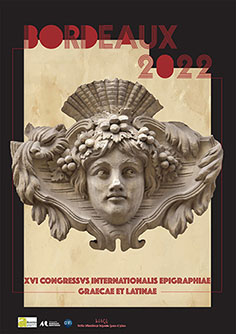Pawel’s paper at the 16th International Congress of Greek and Latin Epigraphy, Bordeaux

On Friday, 2 September 2022, Pawel will be giving a paper titled “People, their Language, and their Inscriptions: Inscribing Greek in the Early Byzantine Middle East” at the 16th International Congress of Greek and Latin Epigraphy, 29 August–2 September 2022, Bordeaux.
Abstract: The actual spread of Greek as a spoken language in the Roman and early Byzantine Middle East (fourth–seventh century) has been passionately debated, even more since the days of the so-called “Johnson–Millar” controversy, Greek inscriptions always playing an important part in it. This paper will present the author’s first thoughts on the possibilities of studying the mother tongue (if we are to use this term) of the people who drafted the text of Greek building inscriptions on stone and mosaics from Syria and Palestine, through a systematic exploration of their syntax. That the sentence structure or word order can be a meaningful premise for identifying linguistic identities of users of their second language, was signalled by a number of scholars, among them quite forcefully by Julian Obermann in his study of the Greek epigraphy of Qalʿat Simʿān in the 1940s. The author will look into his methods and discuss the possibilities of their wider application to the research on Greek inscriptions from the region. The paper is part of “Epigraphy and Identity in the Early Byzantine Middle East”, a project in cross-lingual comparative epigraphy, exploring the reasons and impact of the choice of language in stone and mosaic inscriptions from late antique Syria, Phoenicia, Palestine, and Arabia.
The paper is part of the session 20 “Epigraphic traditions after the reign of Diocletian” organized by Adam Łajtar (University of Warsaw) and Cécile Treffort (University of Poitiers).
List of papers in this panel:
- Cécile Treffort, Adam Łajtar, Introduction
- Jean Guyon, Marc Heijmans, Morgane Uberti, Du Recueil des Inscriptions Chrétiennes aux Inscriptions de la Gaule Chrétienne : héritage, filiation et renouveau de l’épigraphie de la Gaule tardo-antique et alto-médiévale (Projet IGAMA : Poitiers-Aix-Bordeaux)
- Alberto Bolaños Herrera, Culture littéraire et épigraphie dans l’Antiquité tardive: Virgile et la mosaïque d’Estada (Huesca)
- Ilenia Gradante, Burial and visual culture in the Christian community of Siracusa: The epigraphic evidence from the catacombs
- Paweł Nowakowski, The People, their Language, and their Inscriptions: Inscribing Greek in the Early Byzantine Middle East
- Simeon D. Ehrlich, Epigraphic and Paraepigraphic Signifiers of Ecclesiastical Architecture in Late Antique Palestine
- Arkadij Avdokhin, Greek Pilgrims’ Inscriptions in Late Antiquity: What Difference Did Christianity Make?
- Anna M. Sitz, Contextualizing Damnatio Memoriae: Epigraphic Erasures in Late Antique Cityscapes (4th–7th c. AD)
- Estelle Ingrand-Varenne, La seconde vie des inscriptions : relecture médiévale des témoignages épigraphiques antiquesNicholas Melvani, “Protecting the City: Monumental Epigraphic Apotropeia”